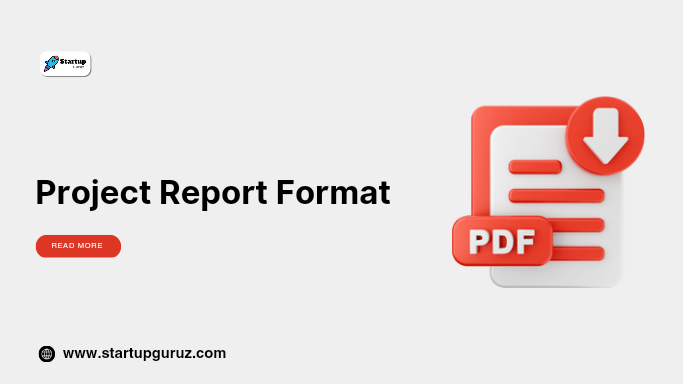Project Report Format
Comprehensive Guide to Project Report Format
Creating a project report is a critical step for any business or project proposal. It not only provides detailed insights into the project but also serves as a blueprint for its execution. A well-prepared project report format is essential for conveying the purpose, scope, and financial feasibility of a project to stakeholders, banks, and investors.
In this guide, we’ll cover a step-by-step format for project reports, along with its importance, tips for drafting a professional report, FAQs, and more.

What is a Project Report Format?
A project report format is a structured layout used to document the objectives, planning, execution, and outcomes of a project. It helps in presenting key details like financial estimates, marketing strategies, risk analysis, and operational plans in a systematic manner.
Why is it Important?
- Clarity: Ensures all stakeholders have a clear understanding of the project.
- Decision-Making: Facilitates informed decisions by investors and financial institutions.
- Accountability: Acts as a reference for project milestones and outcomes.
- Loan Approvals: Required by banks for loan applications under various government schemes.
Key Components of a Project Report Format
1. Title Page
The title page includes:
- Project Title
- Organization Name
- Prepared By
- Submission Date
Example:
Project Title: Organic Farming Venture in [Location]
2. Table of Contents
A well-organized table of contents allows readers to navigate through the report easily.
3. Executive Summary
Provide a concise overview of the project, summarizing its objectives, scope, and financial requirements.
Example:
“This project aims to establish an organic farming business with an estimated investment of ₹15,00,000 and a revenue projection of ₹25,00,000 annually.”
4. Introduction
Describe the purpose and background of the project. Include details like industry trends and the rationale for selecting this project.
5. Project Objectives
Clearly outline the short-term and long-term goals.
Example:
- Launch the business by [date].
- Achieve 30% market share within the first year.
6. Market Analysis
Include:
- Target Market
- Competitor Analysis
- Demand and Supply Trends
7. Technical Details
Explain the technical aspects, such as:
- Technology to be used
- Infrastructure requirements
- Production processes
Example:
“State-of-the-art equipment for organic compost production will be installed to ensure high-quality output.”
8. Financial Plan
Provide:
- Initial Investment
- Operational Costs
- Revenue Projections
- Profit Margins
Example:
| Expense | Cost (₹) |
|---|---|
| Land Acquisition | 5,00,000 |
| Equipment | 4,00,000 |
| Marketing Budget | 1,50,000 |
| Miscellaneous | 50,000 |
| Total | ₹15,00,000 |
9. Risk Analysis
Identify potential risks and provide mitigation strategies.
Example:
- Risk: Market fluctuations
- Mitigation: Establish long-term contracts with buyers
10. Implementation Plan
Provide a timeline for various stages of the project, such as procurement, production, and marketing.
Example:
| Stage | Timeline |
|---|---|
| Land Preparation | 1 Month |
| Equipment Setup | 2 Months |
| Production Start | 3 Months |
11. Conclusion
Summarize the project’s feasibility and benefits.
Tips for Writing a Professional Project Report
- Use Simple Language: Avoid jargon to ensure easy readability.
- Be Accurate: Double-check financial data and projections.
- Include Visuals: Use charts, graphs, and tables for clarity.
- Proofread: Ensure the report is error-free.
- Follow Standard Guidelines: Adhere to any specific format required by stakeholders or banks.
FAQs About Project Report Format
1. What is the purpose of a project report?
A project report provides a detailed plan and analysis, helping stakeholders understand the project’s objectives, scope, and feasibility.
2. Is a project report necessary for loan approval?
Yes, most banks and financial institutions require a detailed project report for approving loans.
3. What software can I use to create a project report?
Common tools include Microsoft Word, Excel, Google Docs, and specialized project management software.
4. How long should a project report be?
It depends on the project’s scope but typically ranges from 10 to 30 pages.
5. Can I include visual elements in a project report?
Yes, charts, graphs, and images can make the report more engaging and easier to understand.
6. What is the difference between a project report and a business plan?
A project report focuses on a specific project, while a business plan outlines the overall strategy of a business.
7. How do I calculate the financial feasibility of a project?
Include detailed cost estimates, revenue projections, and a break-even analysis in the financial plan section.
8. Is market analysis mandatory in a project report?
Yes, market analysis is crucial for understanding demand, competition, and pricing strategies.
9. How can I ensure my project report is SEO-friendly?
Use relevant keywords, clear headings, and a structured format for better readability and search engine ranking.
10. Can I hire professionals to prepare my project report?
Yes, many consultants specialize in drafting project reports for various industries.